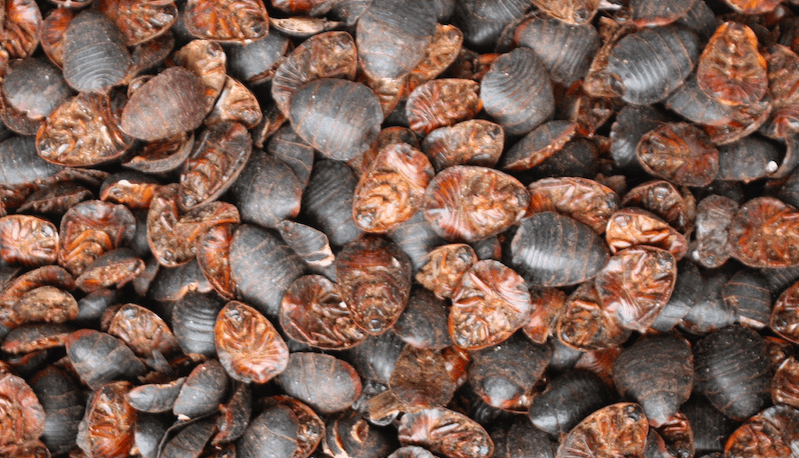Eupolyphaga, Tu Bie Chong 土鳖虫Ground Beetle, Wingless CockroachTu Bie Chong (TCM) |

|
 Tu Bie Chong
Tu Bie Chong(Adam, Chengdu Medicine Market, 2009)
Entomological name:
Eupolyphaga sinensis is the official species.
Other species supplying the market include:
- E. thibetana
- E. everestians
- Polyphaga plancyi
- Opisthoplatia orientalis
Parts used:
Whole dried insect
Temperature & Taste:
Cold, dry. Salty. Slightly Toxic
Constituents:
Nutrient rich: Proteins (21–54 g/100 g dry weight), lipids (33.40 g/100 g dry weight), essential fatty acids, vitamins, trace minerals (1–7 g/100 g dry weight)
Classifications:
Uses:
1. Strongly Moves the Blood, Clears Stasis:
-Amenorrhea, Dysmenorrhea
-Postpartum Blood Stagnation
-Abdominal Masses, Fibroid Tumors, Cancer
-enlarged Liver, or Hardness of the Liver or Spleen
-also memory impairment from poor cerebral circulation
-regarded as one of the strongest ‘Blood-breaking’ medicine in TCM
2. Moves the Blood, Promotes Healing of the Sinews and Bones:
-Trauma, Bruising
-Injury to the soft tissue of the joints, Fractures
Dose:
Decoction: 3–9 grams
Powder: 500–1500mg
Tincture (1:5 in 90% alcohol): 2–5 mls.
Comment:
This is a potent medicine to move the Blood, regarded as similar in strength to Leech which contains powerful anticoagulants. However, this is regarded as more suitable for weak patients.
Preparation:
1. Typically, they are killed with boiling water, then dried in the sun or a low oven.
2. Dry-fried Wingless Cockroach (Chao Tu Bie Chong)
Dry fry in a wok until scorched. This reduces toxicity, helps sterilize and reduces the foul smell.
Substitute:
I. Pill Millipede has been used in the West very similarly to Eupolyphaga in TCM. It can be used as a substitute, especially for Masses and Tumors associated with Blood Stasis.
2. Wingless Cockroach is used as a substitute for Pangolian scales (Chuan Shan Jia) when used to break blood stasis and resolve masses.
Main Combinations:
1. Blood Stasis:
i. Eupolyphaga with Rhubarb (Da Huang), Dang Gui, Leech (Shui Zhi), Tabanus (Meng Chong), Toxidendron resin (Gan Qi), Peach kernel (Tao Ren), Scutellaria Huang Qin, Paeonia Bai Shao, Rehmannia Sheng Di Huang, Apricot kernel (Xing Ren), Licorice (as in Da Huang Zhe Chong Wan)
ii. to strongly resolve Blood Stasis, Eupolyphaga with Leech (Shui Zhi), Earthworm (Di Long)
2. Abdominal Masses, Eupolyphaga with Rhubarb,
3. Enlarged Liver or Hardness of the Liver, Eupolyphaga with Curcuma Yu Jin, Notoginseng San Qi
4. Cirrhosis, Eupolyphaga with Cremastra Shan Ci Gu
5. Gynecological Tumors, Eupolyphaga with Zedoary (E Zhu)
6. Postpartum Abdominal Pain from Blood Stasis, Eupolyphaga (20 in number), Peach kernel (Tao Ren) (20), Rhubarb (Da Huang) (6 grams). Form 4 pills with Honey. Simmer one pill is wine and drink the warm decoction. (Zhang Zhong Jiang Fang, TCM)
7. Severe pain from Gout or Arthritis, Eupolyphaga with Wasp Nest (Feng Fang), Centipede (Wu Gong), Spatholobus Ji Xue Teng
8. Trauma, Bruising:
i. Eupolyphaga with Frankincense and Myrrh
ii. Eupolyphaga with Notoginseng San Qi, Dang Gui, Peach kernel (Tao Ren), Safflower (Hong Hua), Dragon’s Blood (Xue Jie), Dipsacus Xu Duan, Frankincense (Ru Xiang), Myrrh (Mo Yao), Licorice (as in Die Da Wan)
iii. Eupolyphaga with Notoginseng San Qi, Dang Gui, Borneo Camphor (Bing Pian), Frankincense (Ru Xiang), calcined Pyrite, prepared as a powder for oral administration (as in Huo Xue Zhi Tong San of the Chinese Pharmacopoeia)
iv. Eupolyphaga with Notoginseng San Qi, Dang Gui, Safflower (Hong Hua), Ligusticum Chuan Xiong, Borneo Camphor (Bing Pian), Methyl Salicylate, extract of Belladonna, prepared as a plaster for topical application (as in Hong Yao Tie Gao of the Chinese Pharmacopoeia)
9. Fractures:
i. stir-fry Eupolyphaga, powder and take 6–9 grams of the powder. ‘Works miraculously to knit broken bones’. (Yang Gong Zhai Yao Fang, TCM)
ii. Eupolyphaga with Drynaria Gu Sui Bu
iii. Eupolyphaga (baked until dry, 18 grams), Pyrite (quenched in vinegar 7 times, 60 grams). Grind into powder, take 6 grams with wine as a dose.
Major Formulas:
Da Huang Zhe Chong Wan
Die Da Wan
Cautions:
1. Not used during Pregnancy
2. Only suitable for use in those with Blood Stagnation (fixed pain, masses, cyanosis of the nail beds or tongue and a choppy pulse)
3. Allergic skin reactions have been reported. Its use should be discontinued if skin rashes appear.
Toxicity:
It is mildly toxic. Side effects may include nausea, gastrointestinal irritation, weakness and vertigo.
